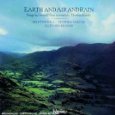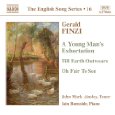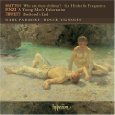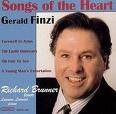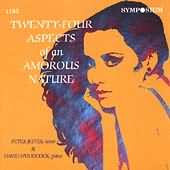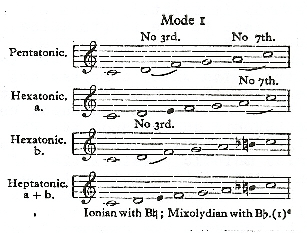Her Temple
- Musical Analysis Section
- Audio Recordings Section
- Unpublished Analysis Excerpts
- Van der Watt - The Songs of Gerald Finzi (1901-1956) To Poems by Thomas Hardy
- Carlisle - Gerald Finzi: A performance Analysis of A Young Man's Exhortation and Till Earth Outwears, Two Works for High Voice and
- Denning - A Discussion and Analysis of Songs for the Tenor Voice Composed by Gerald Finzi with Texts by Thomas Hardy
- Rogers - A Stylistic Analysis of A Young Man's Exhortation, Opus 14, by Gerald Finzi to words by Thomas Hardy
- Bray - An Analysis of Gerald Finzi's "A Young Man's Exhortation"
- John Keston - Two Gentlemen from Wessex, The Relationship of Thomas Hardy's Poetry to Gerald Finzi's Music
Poet: Thomas Hardy
Date of poem: (undated)
Publication date: 1922 within the collection: Late Lyrics and Earlier
(Purdy, 214)
Publisher: Macmillan Publishing Company
Collection: Late Lyrics and Earlier
History of Poem: James Osler Bailey, in his book, The Poetry of Thomas Hardy says the poem "Her Temple" "echoes the thought of Shakespeare's sonnet XVIII: 'So long as men can breathe, or eyes can see, / So long lives this, and this gives life to thee.' " Bailey also believes the woman in the poem to be Hardy's first wife Emma and that the Poems of 1912-13 are the "temple" mentioned both in the poem as well as the title. In a side note Bailey lists the composer John Ireland as one who has also set the poem. The song is part of Ireland's Five Poems by Thomas Hardy published by Oxford University Press in 1927. (Bailey, 466)
Poem
| 1 | DEAR, think not that they will forget you: | a |
| 2 | - If craftsmanly art should be mine | b |
| 3 | I will build up a temple, and set you | a |
| 4 | Therein as its shrine. | b |
| 5 | They may say: ‘Why a woman such honour?’ | c |
| 6 | - Be told, ‘O, so sweet was her fame, | d |
| 7 | That a man heaped this splendour upon her; | c |
| 8 | None now knows his name.’ | d |
(Hardy, 628) |
||
Content/Meaning of the Poem:
Never fear, I will not forget you
With all of my abilities
I will write poems about you
That will forever encapsulate your memory.
Some may wonder why I have gone to such measures to honour her
It was, because she was so beautiful
That he built this memorial for her
His name is now forgotten.
For additional comments as to possible meaning of the text please refer to: Content - Van der Watt.
Speaker: Possibly Thomas Hardy
Setting: Nothing specific is mentioned in the poem as to the setting.
Purpose: To memorialize the memory of Hardy's first wife Emma.
Idea or theme: Love lives on even after death.
Style: Gerhardus Daniël Van der Watt commented in his dissertation that "the poem is in the style of a love lyric, almost an epitaph, consisting of a single extended metaphor: The beloved becoming a shrine." (Van der Watt, 104)
Form: Gerhardus Daniël Van der Watt in his analysis of the poem describes the form as "two quatrains with lines of uneven length and a rounded rhyme scheme." Dr. Van der Watt goes on to say, "the textual metre is largely anapestic and dactylic with a number of irregularities especially in the second stanza." (Van der Watt, 104) To view Dr. Van der Watt's comments about the poem please refer to: Form - Van der Watt.
Synthesis: It is most probable that Hardy wrote this poem in tribute to his deceased wife, Emma. He wrote a number of poems after her death and this is one of the shorter poems in her memory. In the poem he seems to be reaching out to her and offering reassurance as to her memory. There is also some guilt on Hardy's part for the distance that had come between the two of them in their last years together. Hardy begins the second stanza with a rhetorical question, asking "why a woman such honor." It seems clear that Hardy wanted those that read the poem to ponder how wonderful Emma truly was otherwise why would he have built in her memory a temple of poems. Another curiosity of the poem is Hardy humbling himself deeply in the last line, with the text, "His name is now forgotten." If one considers Hardy's fame as a poet/novelist how could he have thought his fame would be forgotten. It can be safely said today that Thomas Hardy will not be forgotten and to a certain degree his wife, Emma will not as long as there are those who read and study the poems Hardy wrote in Emma's memory.
✦✼✦✼✦✼✦✼✦✼✦✼✦✼✦✼✦✼✦✼✦✼✦✼✦✼✦✼✦✼✦✼✦✼✦
Late Lyrics and Earlier
- Collection of 151 poems written by Thomas Hardy.
- Published: May 23, 1922 by Macmillan and Company.
- "Chiefly lyric voicings of impressions." "Many reflect the mulling over of memories, the fruit of notebooks (at a time when he was making notes toward his biography), and the rediscovery of old poems rejected from previous volumes." (Bailey, 428)
- The poems date from the 1860's through 1921 except for the 1880's.
- Hardy wrote a 'Preface' for the collection entitled: "Apology." Within the "Apology" Hardy expresses his resentment towards those that have labeled his poetry "awkward and his philosophy bleak." (Wright, 191)
R. L. Purdy describes the collection of poems as, "the most representative of Hardy's whole career." (Pinion, 162)
F. B. Pinion commenting on the collection said, "the period of remorse and emotional stress seems to be at a distance, and a lighter kind of lyric comes to the fore, not always designated as 'song' but written as if for music, and relatively detached, even when based on recollections of Emma Hardy." (Pinion, 162)
Gerald Finzi set the following poems within this collection:
- After Reading Psalms XXXIX, XL etc. [titled by Finzi as: So I Have Fared] (Earth and Air and Rain)
- A Young Man's Exhortation (A Young Man's Exhortation)
- Epeisodia (Before and After Summer)
- Her Temple (A Young Man's Exhortation)
- The Master and the Leaves (By Footpath and Stile)
- Summer Schemes (Earth and Air and Rain)
- Voices from Things Growing in a Churchyard (By Footpath and Stile)
Helpful Links:
✦✼✦✼✦✼✦✼✦✼✦✼✦✼✦✼✦✼✦✼✦✼✦✼✦✼✦✼✦✼✦✼✦✼✦
Musical Analysis
Composition date: 1927 (Banfield, 144)
Publication date: Copyright 1933 by Oxford University Press, London.
Copyright © assigned 1957 to Boosey & Co. Ltd. (Finzi, 146)
Publisher: Boosey & Hawkes - distributed by Hal Leonard Corporation
Tonality: The song is primarily in E flat major with some chromatic material that gives the aural impression of being modal at times. Finzi begins transitioning to F minor near the end of the song in measure fifteen and remains in F minor for the conclusion. Gerhardus Daniël Van der Watt, in his dissertation says, "this minor turn emphasizes and enhances the intensified emotional contents of the last part of the song and anticipates the sombre final line of the poem, 'None now knows his name.' " (Van der Watt, 108) To view Dr. Van der Watt's comments please refer to: Tonality - Van der Watt. Carl Rogers has prepared a table in his thesis in which he discusses the fluctuations between major and minor tonalities within the song. Dr. Rogers uses a study by Cecil Sharp to justify his opinion. To view his table as well as his comments please refer to: Table VI - Rogers. Michael R. Bray in his thesis also discusses the tonality and the harmony used by Finzi in this song and to view his comments please refer to: Tonality - Bray.
Transposition: Currently unavailable.
Duration: Approximately one minute and fifty-eight seconds.
Meter: Finzi primarily uses 4/4 but he does deviate to 3/4 two times and uses 5/4 once. The piano introduction for the song begins in four. Then in measure four it transitions to three for one measure. Finzi then returns to four in measure five and remains in four until the end of the first stanza when he utilizes three once again for one measure only. As the second stanza begins in measure thirteen he returns to four. The single occurrence of five happens in measure sixteen before Finzi once again returns to four. Leaving the remaining three measures of the song in four. For additional information about meter within the song please refer to: Metre - Van der Watt.
Tempo: The score indicates Espressivo, flowing with the quarter note equalling c. 66. There are a few deviations from the opening indication but all of them occur in the second stanza. The first tempi change occurs in measure twelve with meno mosso indicated followed quickly in measure thirteen with largamente. Between measures sixteen and seventeen poco ritardando is indicated as the song comes to a close on the text "None now knows his name." For further discussion about the tempi within the song please refer to: Speed - Van der Watt. Mark Carlisle, in his dissertation comments that the tempo marking of c. 66 may be a little fast and therefore he recommends c. 52. (Carlisle, 123) To see Dr. Carlisle's comments about the tempo and other performance practice remarks please refer to: Comments about Performance - Carlisle.
Form: The song is through-composed but there are some occurrences of repeated material. Michael R. Bray in his thesis comments on the short phrases that Finzi uses in the song, often as short as one measure. Bray surmises Finzi was attempting to give the listener "short but beautiful glimpses at loveliness." (Bray, 30) To see Dr. Bray's comments about the phrases please refer to: Phrases - Bray. To view Dr. Bray's comments in total please refer to: Music - Bray. One can fathom that, like Hardy, Finzi wanted to create fissures of beauty in his musical composition that might translate as visions of Hardy's first wife, Emma or at least the beauty that Hardy held for her, imagined by Finzi. Another interesting observation about the form of the song can be found in the repeated material found in the piano accompaniment. For example the opening theme in the first four measures of the piano accompaniment is repeated at the end of the first stanza beginning with the last beat of measure eight and continuing on to the beginning of measure thirteen where the vocal line resumes with the second stanza of the text. A fragment of the introduction is imitated yet again in the last two measures of the accompaniment although not exact it is nevertheless imitation in the right hand of the piano accompaniment (see examples below).
Introductory theme in measures 1-4. (Finzi, 146)
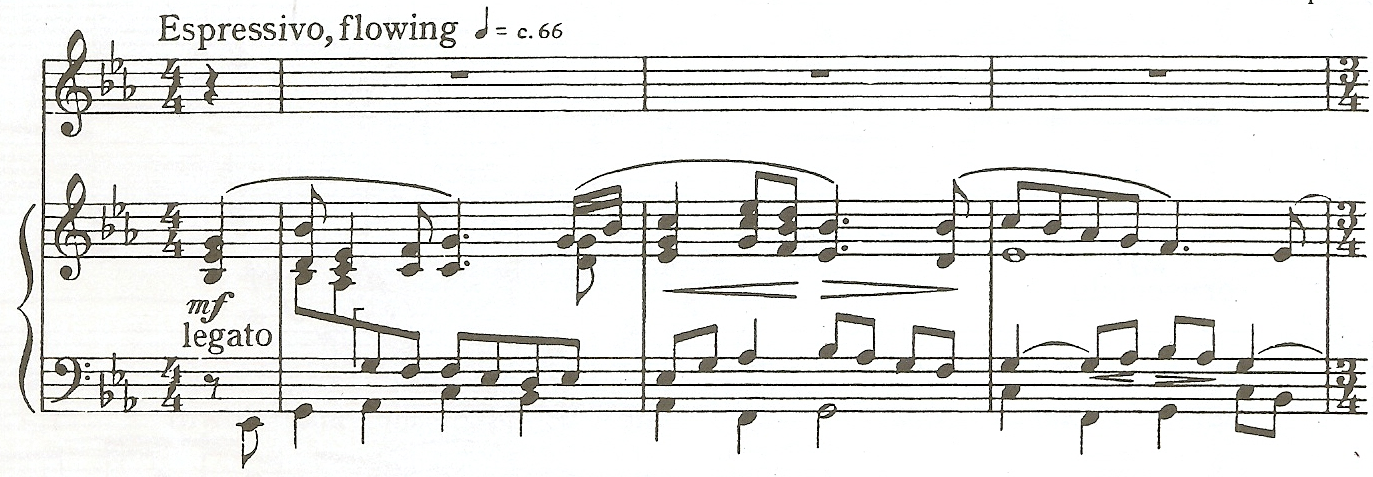
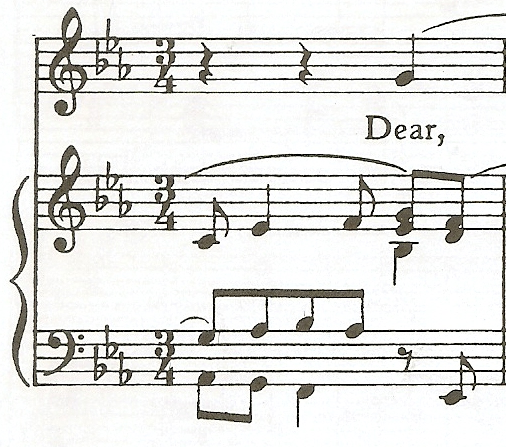
Introductory theme returns in measures 7-12. (Finzi, 146-7)
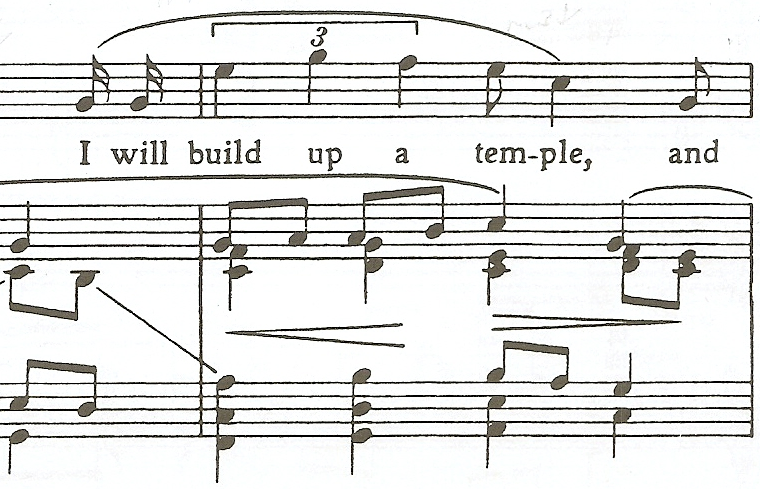

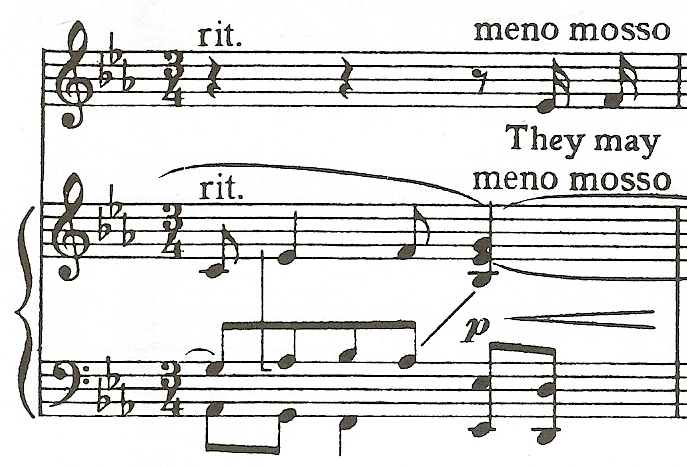
Fragment of introductory theme, measures 18-9. (Finzi, 147)
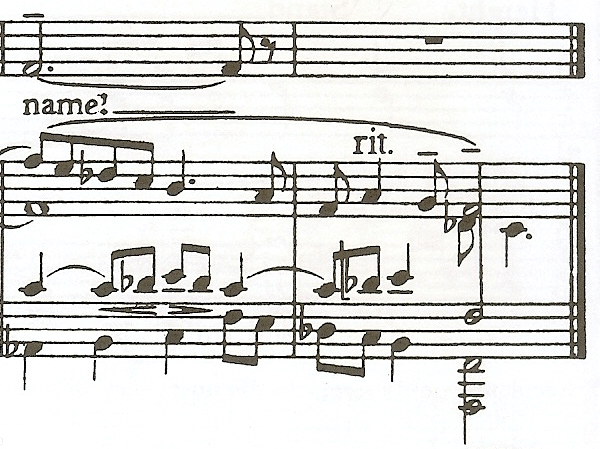
It is not unusual for Finzi to repeat material in the piano accompaniment and possible influences that may have led to this compositional device possibly stem from earlier contrapuntal studies Finzi had with R. O. Morris and others while he studied music formally in London. It may also have to do with his frequent use of fragments of music that he envisioned for a piece of text. The melodic fragment or theme may have been a product from one of those that he kept in his desk as he worked on his songs. For additional information about the specific sections of the song and other information about the form written by Gerhardus Daniël Van der Watt please refer to: Structure - Van der Watt.
Rhythm: Finzi's use of rhythm in the song is typical with the second stanza showing more skill at text setting than the first. Mark Carlisle in his dissertation comments, "there is little that is rhythmically unusual in this piece except for one aspect; the initial rhythmic motive heard first in the accompaniment and echoed by the voice throughout the song adds a slight touch of syncopation that gives the song a bit of refreshing complexity." (Carlisle, 119-20) To view Dr. Carlisle's comments as to the rhythm please refer to: Rhythm - Carlisle. The rhythmic duration choices for the vocal line are typical for Finzi. The shortest duration is that of a sixteenth note and longest he reserves to end each stanza. For a discussion about the rhythm and the rhythmic motifs of the song please refer to: Rhythm - Van der Watt.
A rhythmic duration analysis was performed on the song and to view the results please refer to: Rhythm Analysis. Information contained within the analysis includes: the number of occurrences a specific rhythmic duration was used; the phrase in which it occurred; the total number of occurrences in the entire song.
Melody: The vocal line is not unusual for Finzi but considering the brevity of the song there are several occurrences of an interval of a fourth or greater, with this in mind, the largest number of intervals within the vocal line are still smaller than a perfect fourth. Gerhardus Daniël Van der Watt has carefully analyzed the melodic material of the song and in doing so has created tables as well as written a number of comments about the melodic material within the song. To see his remarks please refer to: Melody - Van der Watt. Mark Carlisle has also written a number of comments about the melodic material within the song and his comments also contain remarks about melodic motives. To view his comments please refer to: Melody - Carlisle.
An interval analysis was performed on this song for the purpose of discovering the number of occurrences specific intervals were used and also to see the similarities if there were any between stanzas. Only intervals larger than a major second were accounted for in the interval analysis. For a complete description of the results of the interval analysis please refer to: Interval Analysis.
Texture: The texture is contrapuntal with some homophonic texture occasionally. Mark Carlisle in his dissertation comments, "texture is also another area that for the most part remains consistent from beginning to end. Like many of Finzi's songs, this one is basically contrapuntal in texture, with moving bass line reflecting the more homophonic hymn tradition of English church music." (Carlisle, 119-20) Carl Rogers has also made some comments in his thesis about the texture and more specifically the contrapuntal activity. To view his comments please refer to: Counterpoint - Rogers. Gerhardus Daniël Van der Watt gives a brief description in his dissertation about the texture including a table outlining the types of texture and the percentage in which they were used. To view his comments please refer to: Texture - Van der Watt.
Vocal Range: The vocal range spans an interval of a diminished twelfth. The lowest pitch is the D below middle C and the highest pitch is the A flat above middle C.
Tessitura: The song has an tessitura of one octave from the E flat below middle C to the E flat above middle C. A pitch analysis was performed for the purpose of accurately determining the tessitura and for the complete results please refer to: Pitch Analysis.
Dynamic Range: The vocal line has a single dynamic assigned to it and it does not appear until the last line of the song when pianissimo is indicated for the text, "None now knows his name." One must assume that Finzi would like the vocalist to adhere to the dynamics listed in the piano accompaniment but some of them don't seem to line-up perfectly with the vocal line. For example in measure eight there is a crescendo - decrescendo indication but when one leaps from the G below middle C to the E flat above middle C there would be a natural crescendo and that would seem to precede the crescendo in the piano accompaniment. Perhaps this song is one of those that Finzi would like to leave the dynamic interpretation to that of the vocalist. He commented once to Howard Ferguson that he thought dynamic and other marks for interpretation should be left to the performers. Ferguson explained to him however that doing so could possibly alter Finzi's vision for the song. Nevertheless this song could benefit with having additional marks for interpretation. Gerhardus Daniël Van der Watt in his analysis of the song has made a table for all the dynamics of each stanza. To view the table as well as his comments please refer to: Dynamics - Van der Watt.
Accompaniment: Gerhardus Daniël Van der Watt has also made several comments about the accompaniment as he references a number of performance practices: "The atmosphere of the song is quiet but intense (Espressivo, flowing, b. 0⁴). There is a suspension in virtually every bar and many more accent non-harmonic tones which create dissonance on the beat which enhances the emotional character of the music. The atmosphere darkens towards the end with the advent of f natural minor and a number of other lowered pitches. This more sombre atmosphere largely anticipates the final line, "None now knows his name."
(Van der Watt, 105) To view all of Dr. Van der Watt's remarks about the accompaniment please refer to: Accompaniment - Van der Watt.
Pedagogical Considerations for Voice Students and Instructors: This song is highly accessible for the tenor voice but there are two sections where the range rises to the [G] above middle [C] and above. In measure eight there is a [G] on the word "up" this may cause some to glottal the vowel or others to "muscle" the voice up to the high [G]. If one has difficulty with this note observe also the breath before the text "I will" leading up to the high note. One suggestion for correcting the tendency to place a glottal on the word "up" would be to insert the consonant [s] in front of "up." If one is "muscling" the voice first try the phrase without the text and instead utilize a syllable such as [fi] or [fE]. Both will insure good breath flow and the consonant [f] will take away the potential back pressure and heaviness it creates. The next area of difficulty occurs in measures fourteen and fifteen. The high [A] is in the later but there is a [F] on the word "fame" at the end of fourteen that could possibly set one up poorly for the high [A]. If one is encountering difficulty with these two measures try observing the mouth when singing the word "fame." If the corners of the mouth tend to spread while sustaining the word try modifying the vowel toward [E]. If the trouble seems to solely rest on the high [A] first observe the breath before "That" also if one is going to the consonant [n] early while sustaining the high [A] this can cause a heaviness in the voice with the added back pressure. The [sp] in front of the high note is excellent for the voice and should cause no problems.
Dr. Mark Carlisle records in his dissertation the following observations and advice: "This is among the technically easiest pieces in this cycle, with a text that is not particularly difficult to understand or interpret. The only difficult spot technically for a young tenor might be the approach to a¹ in measure 15, but as this is not a sustained note, it would probably cause few if any problems. The tessitura in general is quite acceptable, so it would not be out of line to suggest this particular song to a relatively young tenor. Naturally, he would need some minimal literary and artistic skills, but a junior or senior undergraduate student should be more than capable of providing a very satisfying performance. It is one of the most inherently beautiful pieces in this cycle, and should be seriously considered by any who appreciate the unique qualities of the English solo song." (Carlisle, 124)
✦✼✦✼✦✼✦✼✦✼✦✼✦✼✦✼✦✼✦✼✦✼✦✼✦✼✦✼✦✼✦✼✦✼✦
Below one will find excerpts from unpublished dissertations and theses. The excerpts should provide a more complete analysis of Her Temple for those wishing to see additional detail. Please click on the link or scroll down.
Gerhardus Daniël Van der Watt - The Songs of Gerald Finzi (1901-1956) To Poems by Thomas Hardy
Michael R. Bray - An Analysis of Gerald Finzi's "A Young Man's Exhortation"
✦✼✦✼✦✼✦✼✦✼✦✼✦✼✦✼✦✼✦✼✦✼✦✼✦✼✦✼✦✼✦✼✦✼✦
| Pitch Analysis | ||||
|---|---|---|---|---|
| pitch | stanza 1 |
stanza 2 |
total | |
highest |
A flat |
0 |
1 |
1 |
G |
1 |
1 |
2 |
|
F |
1 |
2 |
3 |
|
E |
4 |
3 |
7 |
|
D |
0 |
2 |
2 |
|
middle C |
3 |
8 |
11 |
|
B |
6 |
4 |
10 |
|
A |
2 |
4 |
6 |
|
G |
9 |
4 |
13 |
|
F |
2 |
2 |
4 |
|
E |
3 |
2 |
5 |
|
lowest |
D |
1 |
0 |
1 |
Audio Recordings
The Songs of Gerald Finzi to Words by Thomas Hardy
|
|
|
|
Gerald Finzi Song Collections |
|
|
|
The English Song Series - 16 |
|
|
|
Song Cycles for Tenor & Piano by Gerald Finzi |
|
|
|
Songs by Britten, Finzi & Tippett |
|
|---|---|
|
|
Songs of the Heart: Song Cycles of Gerald Finzi |
|
|
|
Twenty-Four Aspects of an Amorous Nature |
|
|
|
The following is an analysis of Her Temple by Gerhardus Daniël Van der Watt. Dr. Van der Watt extended permission to post this excerpt from his dissertation on October 8th, 2010. His dissertation dated November 1996, is entitled:
The Songs of Gerald Finzi (1901-1956) To Poems by Thomas Hardy
This excerpt comes from Volume II and begins on page one hundred four and concludes on page one hundred ten. To view the methodology used within Dr. Van der Watt's dissertation please refer to: Methodology - Van der Watt.
1. Poet
Specific background concerning poem:
"The poem comes from Late Lyrics and Earlier (1922) and is undated. The poem is possibly written to Emma who had died ten years prior to the poem's publication."
(Van der Watt, 104)
2. Poem
"The persona, a poet, probably Hardy, addresses his deceased beloved, probably Emma and reassures her that he will not allow the memory of her to fade. In the words of poems like this one, he will visually entomb her memory. When people ask why such honour on was bestowed on her, the answer would be that she was immensely famous for her sweetness, so much so that even the poet was forgotten. Seen in a Thomas - Emma perspective, the undercurrent is very interesting: Hardy already world famous by 1922 when the poem was published, proposes that this poem and presumably others about Emma, will immortalize her (which it has). The question remains: why does he propose that no-one will know his name? Is it in his extreme modesty that he would like her to shine? Or is he ironically mocking himself, that his fame will not last? One must remember that his sense of loss after Emma's death in 1912 was so profound that a flood of love poems directed towards Emma was written in the following years."
(Van der Watt, 104)
"The poem is in the style of a love lyric, almost an epitaph, consisting of a single extended metaphor: The beloved becoming a shrine."
(Van der Watt, 104)
"The poem consists of two quatrains with lines of uneven length and a rounded rhyme scheme. The textual metre is largely anapestic and dactylic with a number of irregularities especially in the second stanza."
(Van der Watt, 104)
"The poem is a simple lyric with a single image and purpose: the enshrinement of the beloved through poetry. The poem is retrospective and contains an element of guilt on the part of the poet hence his over-reaction in praise and desire to remain nameless."
(Van der Watt, 104-5)
Setting
1. Timbre
VOICE TYPE/RANGE
"The song is set for tenor voice and the range is a diminished twelfth from the first D below middle C."
(Van der Watt, 105)
"The piano accompaniment stays in the middle register of the piano up to bar 13 after which the lower register (third c below middle C) is more fully explored up to bar 17. The higher register of the piano is not tested in this song (second A flat above middle C). The highest and lowest pitches occur in the same bar (b. 16) on adjacent beats. The piano part here, imitates the vocal part of the previous bar which supported the text, "this splendour upon her." The middle to lower and warmer sonority is employed and suits the quiet, retrospective atmosphere of the poem. There are no indications for the use of the pedal but only the legato indication at the beginning. It is up to the performer to use the pedal to achieve the required legato sound. Other indications of articulation are scarce. There are a small number of portamento accents (b. 11, 13, 18 and 19). These highlight important melodic occurrences. There are no stronger accents."
(Van der Watt, 105)
"The atmosphere of the song is quiet but intense (Espressivo, flowing, b. 0⁴). There is a suspension in virtually every bar and many more accent non-harmonic tones which create dissonance on the beat which enhances the emotional character of the music. The atmosphere darkens towards the end with the advent of f natural minor and a number of other lowered pitches. This more sombre atmosphere largely anticipates the final line, "None now knows his name."
(Van der Watt, 105)
2. Duration
"A mainly common time time-signature is interrupted twice with a shortened bar just prior to the start of each stanza. There is also one extended bar. Metre variations are summarized below:"
Bar no. |
Metre |
No. of bars |
Total |
Reason/s |
0⁴ |
4/4 |
3 |
16 |
Chose metre to suit the textual metre generally |
4 |
3/4 |
1 |
2 |
Shortened bar, "Dear" on long upbeat |
5 |
4/4 |
7 |
"Think" on strong beat |
|
12 |
3/4 |
1 |
Shortened bar, "They may" on upbeat |
|
13 |
4/4 |
3 |
"say" on strong beat |
|
16 |
5/4 |
1 |
1 |
Extended bar, "upon" on strong beat |
17 |
4/4 |
3 |
"None" on strong beat |
Rhythmic motifs
"The most prominent motif (motif 1) consists of four quavers [eighth note] and occurs 16 times only in the piano part. It causes the "flowing" movement (specified in bar 1) that the song has and is involved in a number of imitations in the piano part. Motif 2, consisting of a dotted crotchet [dotted quarter note] and quaver (or two semi-quavers) occurs 13 times counting both piano and vocal parts. It is mostly used at the end of sub-phrases as cadential material with the quaver or semi-quavers acting as link to the next phrase. Motif 3, consisting of a quaver, crotchet and quaver pattern, is derived from the vocal line, "think not that." The interval of a fifth between the first two pitches makes this syncopated motif even more conspicuous. The final motif (motif 4) is that of four crotchets and mostly occurs in the bass of the piano part and once in the vocal part, namely the important bar 17. The purpose of this motif which occurs nine times, is to provide a steady moving foundation on which other rhythmic activity can take place."
(Van der Watt, 105-6)
Rhythmic activity vs. Rhythmic stagnation
"The rhythmic flow is fairly even at a quaver speed and only holds back at the climax of the song and the two bars immediately following (b. 15³-17³). This stagnation in rhythmic movement is enhanced by a poco ritardando indication in bars 16 - 17."
(Van der Watt, 106)
Perceptive, erroneous and interesting settings
"The following words and phrases have been set to music perceptively:"
 (Van der Watt, 106)
(Van der Watt, 106)
Lengthening of voiced consonants
"The following words containing voiced consonants have been rhythmically prolonged in order to make the word more singable:"

(Van der Watt, 106)
"The tempo indication is Espressivo, flowing [quarter note equalling] c. 66. Tempo deviations are listed below:"
Bar no. |
Deviation |
Bar no. |
Return |
Suggested reason/s |
12 |
rit. meno mosso |
13 |
Largamente |
Start of second stanza, intensified emotional content |
16-17 |
poco ritardando |
Emphasis, anticipate the end |
3. Pitch
Intervals: Distance distribution
Interval |
Upwards |
Downwards |
Unison |
(13) |
|
Second |
11 |
12 |
Third |
7 |
3 |
Fourth |
4 |
3 |
Fifth |
0 |
3 |
Sixth |
3 |
1 |
"There are 13 repeated pitches (or 22% of the total number), 25 rising intervals (or 42%) and 22 falling intervals (or 37%). The smaller intervals (a third and smaller) account for 46 intervals (77% of the total number) while the larger intervals (fourths and larger) account for 14 (or 23%). The 77% smaller intervals is a fairly high proportion and indicates that the vocal part is vocally sympathetic. A number of larger intervals are listed below."
(Van der Watt, 107)
Interval |
Bar no. |
Word/s |
Reason/s |
5th down |
5 |
think not |
Emphasis on emotional content |
6th up 3rd up |
7-8 |
will build up |
Emphasis, reinforce meaning |
5th up 4th up |
9-10 |
as its shrine |
Reinforce meaning, emphasis |
6th up |
12-13 |
say: Why |
Change of register, reinforce meaning |
4th up |
14 |
her fame |
Reinforce meaning |
6th up |
15 |
this splendour |
Reinforce meaning, emphasis |
5th down |
16 |
upon her |
Emotional content reinforced |
Melodic curve
"A melodic curve of the vocal line is represented below. Certain words are indicated to show the relationship between the melodic curve and the meaning:"

(Van der Watt, 107)
Climaxes
"The two vocal climaxes are given below:"
Bar no. |
Pitch |
Word |
8 |
G |
up |
15 |
A |
splendour |
"The melodic contour of each stanza is carefully balanced within itself and placing the climax one pitch higher in the second stanza, intensifies the setting towards the end. This feature of the song is in happy harmony with the development in the poem."
(Van der Watt, 107)
Phrase lengths
"The sub-phrases are fairly slow tempo, breathing needs to be considered carefully:"
(Van der Watt, 107)
Stanza 1 (b. 5-10) |
Breathe at 7³ and 8⁴(other instances are indicated by rests) |
Stanza 2 (b. 13-18) |
Breathe at 13⁴ (composer's indication) and 15¹ |
"The basic tonality is E flat major with a number of modal colourings. The modulation occurs towards the end of the song (b. 15). There is first a brief encounter with e flat minor (b. 14⁴-15²) and by bar 15³ f natural minor starts to establish itself and remains until the end. This minor turn emphasizes and enhances the intensified emotional contents of the last part of the song and anticipates the sombre final line of the poem, "None now knows his name"."
(Van der Watt, 108)
Chromaticism
"There are a number of chromatic instances, again in the latter part of the song. The G flat on bar 14⁴introduces e flat minor for a moment while the F flat suggests the Neapolitan step in e flat minor. Both chords occur while an F on the word "fame" is sustained in the vocal part. The chromaticism complements the textual meaning by extending the sound scope though heightened dissonance. The dissonance that occurs on 16⁴is the result of a three-part non-harmonic chord (C-E flat-G), accented passing notes and serves as sound-example for the two chromatic instances in bar 17. On bar 17¹, a similar pattern of non-harmonic tones is used, the E natural being the chromatic instance and on bar 17³ a major IV in f minor is sounded against a non-chordal (accented, chromatic, lower auxiliary note) C flat in the bass. This harmonic sequence with its unusually strong dissonance, indicates that the composer read the final line in a tragic light - more so than it may suggest."
(Van der Watt, 108)
"The modal-sound tendencies in the song can be attributed to two factors. The first, a practice of consciously avoiding the dominant chord (first occurrence in b. 5³ then 6⁴and 9¹) and the use of the minor form of the dominant chord in a minor key (b. 17⁴and 18³) and the second, the use of successive minor chords in a major key."
(Van der Watt, 108)
Bar 1²-⁴ii - vi - iii |
||
Bars 2⁴- 3⁴ |
iii - vi - ii - iii₇ - vi |
|
Bars 7³ - 8² |
ii₆ - vi⁶₄ - ii₇ - ii - iii |
|
Bars 9² - 10² |
ii₆ - vi₆ - iii⁶₄ - vi - ii |
|
Bars 11²-⁴ |
ii - iii₇ - vi |
"The quasi-modal harmonic procedures are very much a part of Finzi's sound palette and possibly derive from his extensive study of seventeenth century counterpoint."
(Van der Watt, 108)
Non-harmonic tones
"Non-harmonic tones are numerous and are mostly used on the beat. A number of examples are given. These exclude the suspensions which are present in virtually every bar."
(Van der Watt, 108)
Accented passing notes |
Bars 2¹(G), 5¹(E flat & C), 11²(G), 13⁴(C), 16³(C-E flat-G) |
|
Accented upper and lower auxiliary notes |
Bars 4³(B flat), 6³(A flat), 8⁴(D & F), 10²(D), 12²(B flat), 14²(D & F), 15¹(D flat) etc. |
Harmonic devices
"There are three inverted pedalpoint notes occurring in parallel contexts but on three different pitches: bar 3 (E flat), bar 11 (C) and bar 18 (F). These have no specific relation to the meaning of the text but merely serve as an anchor with a three-part counterpoint around it."
(Van der Watt, 108)
Counterpoint
"Three and four-part free counterpoint is the main texture of the accompaniment, while on occasion brief imitations are found (b. 2-4 four descending quavers, b. 10-12 four descending quavers, b. 18-19 four descending quavers). There are also three short exchanges of material between voice and piano: bars 5³-6² voice - 6³-7¹ piano, 7²-⁴voice - 8¹-³ piano and 15³-16¹ voice - 16²-⁵ piano. These subtly varied imitations provide a unifying cross-reference between the piano and vocal parts."
(Van der Watt, 109)
"Loudness variation is given in the following summary:"
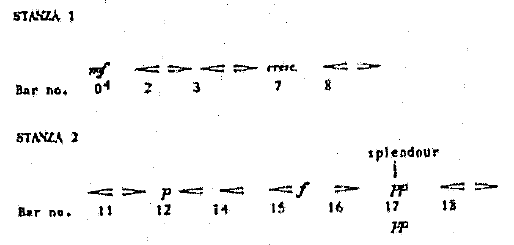
(Van der Watt, 109)
FREQUENCY
"There are 19 indications in the 19 bars which means that on average each bar contains an indication. In reality some bars do not contain indications while others contain two or three. There is only one separate indication for the voice (b. 17 pp) which implies that the voice should follow the indications given in the piano part."
(Van der Watt, 109)
RANGE
"The lowest level indication, pp occurs in bar 17 on the words "none now knows his name", and provides a dramatic anti-climax three bars from the end. The loudest level indicated, f occurs just one and a half bars earlier on the word "splendour", the vocal climax of the song."
(Van der Watt, 109)
VARIETY
"The indications used are:"

(Van der Watt, 109)
DYNAMIC ACCENTS
"There are no stronger accents than the portamento and the ones occurring in the piano part have been listed before. The last two vocal pitches (b. 17 and 18) are furnished with portamento accents which draw attention to the importance of the text, "his name"."
(Van der Watt, 109)
"The density varies loosely between four and seven parts including both piano and voice. The thickness of the piano part is represented in the following table:"
No. of parts |
No. of bars |
Percentage |
3 parts |
4 |
21 |
4 parts |
8 |
42 |
5 parts |
6 |
32 |
6 parts |
1 |
5 |
"A four- and five-part texture dominates. The single bar which has a six-part texture appropriately accompanies the words "I will build up a temple"; the texture reinforcing the meaning. A five-part texture prevails from bars 13 to 19, supporting the build up to the climax in bar 15 and intensification of emotional content towards the end of the song."
(Van der Watt, 110)
"The structure of the song is represented in the following table:"
 (Van der Watt, 110)
(Van der Watt, 110)"The vocal part is through-composed but there are numerous references to earlier material in the piano part. The first four bars are repeated with harmonic variation from bars 9 -12 and the second half again in bars 18 - 19. This almost results in a short kind of rondo form: A(b. 1-4) - B(b. 9-12) - C(b. 13-17) - A(b. 18-19)."
(Van der Watt, 110)
7. Mood and atmosphere
"The mood of the song is painstakingly constructed to be quiet and sensitive. It takes a more sombre turn from bars 17 - 19 with the text, "none now knows his name". It almost becomes tragic: the beloved is remembered through the poem, but the poet is forgotten. This can indeed be seen as tragic if the persona is not Hardy. This being not the case, the psychological undercurrent is extremely complicated in which case the darker chromatic end is also justified, if it needs justification at all."
(Van der Watt, 110)
General comment on style
"The writing for the voice is fairly sympathetic. The leaps are not difficult to sing, the most challenging being the consecutive sixth and third in the same direction in bars 7 -8. Harmonically it is mostly tonal with modal tendencies interspersed. A number of interesting chordal inventions occur in the last five bars for the sake of intensified expression. Accented non-chordal tones play an important role in creating dissonance. The quiet attentive atmosphere is successfully manipulated to become darker and more intense towards the end of the song."
(Van der Watt, 110)
Unpublished Analysis Excerpts
The following is an analysis of Her Temple by Mark Carlisle. Dr. Carlisle extended permission to post this excerpt from his dissertation on September 7th, 2010. His dissertation dated December 1991, is entitled:
Gerald Finzi: A Performance Analysis of A Young Man's Exhortation and Till Earth Outwears, Two Works for High Voice and Piano to Poems by Thomas Hardy
This excerpt begins on page one hundred eighteen and concludes on page one hundred twenty-three of the dissertation.
""Her Temple" was published in 1922 as one of Hardy's Late Lyrics and Earlier. James Bailey has suggested that the woman spoken of in this poem is Emma, and that "her temple" refers to the "Poems of 1912-13" that he wrote in her memory. (Bailey, 466) It is certainly among the most straightforward and succinct of the poems in the cycle. Realization of mortality is even more evident in this poem than in the previous one. The poet is clearly speaking in "Her Temple" to one who is still alive, but referring to a time when she will be dead." (Carlisle, 118)
Comments on the Music
"Although this is the shortest song in the entire cycle, it is among the most expressive of all of the songs in this cycle. After the somewhat atypically vigorous and robust quality of the previous song. Budmouth Dears,' this one returns to the more contemplative and gentle musical style more common to Finzi. No musical aspect is used in excess; rather, it incorporates many of Finzi's usual traits, from a beautifully structured vocal melody to subtle rhythmical changes to harmonies filled with light, expressive dissonance. It is not meant to be a 'grand ' piece of musical art; it is instead an honest, direct, musical interpretation of a short but nonetheless powerful poem that cannot help but move even the most impassive of listeners." (Carlisle, 119)
"The piece is a mere nineteen measures in length and is through-composed, certainly not unexpected in light of its brevity. There are two relatively clear sections, however; the first includes measures 1-12, and the second, measures 13-19. The opening key is E flat major, and while this key remains in effect for much of the song, some chromatic transitional material in the final five measures brings the ending to F minor. The song begins with a time signature of 4/4, but a few changes do occur, almost all between 4/4 and 3/4. Only one 5/4 bar can be found, that of measure 16, and its influence is more harmonic than metrical." (Carlisle, 119)
"There is little that is rhythmically unusual in this piece except for one aspect; the initial rhythmic motive heard first in the accompaniment and echoed by the voice throughout the song adds a slight touch of syncopation that gives the song a bit of refreshing complexity. Texture is also another area that for the most part remains consistent from beginning to end. Like many of Finzi's songs, this one is basically contrapuntal in texture, with moving bass line reflecting the more homophonic hymn tradition of English church music." (Carlisle, 119-20)
"As is the case in most of Finzi's best songs, the predominant aspect in this piece is melody, from the first note of the prelude to the final five measures when chromaticism becomes much more pronounced. A melodic motive begins the prelude and spans the first three and a half measures before the vocal line enters and echoes the figure. The melody shared by accompaniment and voice weaves a beautifully expressive arch enriched by passing tones that adds a subtle polyphonic sense to the lines." (Carlisle, 120)
"After the initial vocal presentation of the above mentioned theme, new melodic material is presented in measures 6-10. The opening motive returns in the accompaniment at the end of measure 8 and continues to its conclusion in measure 12, the end of the first section. It should be mentioned here that all three entrances of the motive start at exactly the same pitch level, and all remain in the key of E flat major, even though the motive in the voice line in measures 4-6 does deviate from the other two. This motive is found only in the first section and serves as its only unifying device, but since only two measures in this section do not contain any motivical elements, its importance is considerable." (Carlisle, 120)
"Example 15. 'Her Temple,' measures 1-6." (Carlisle, 121) |
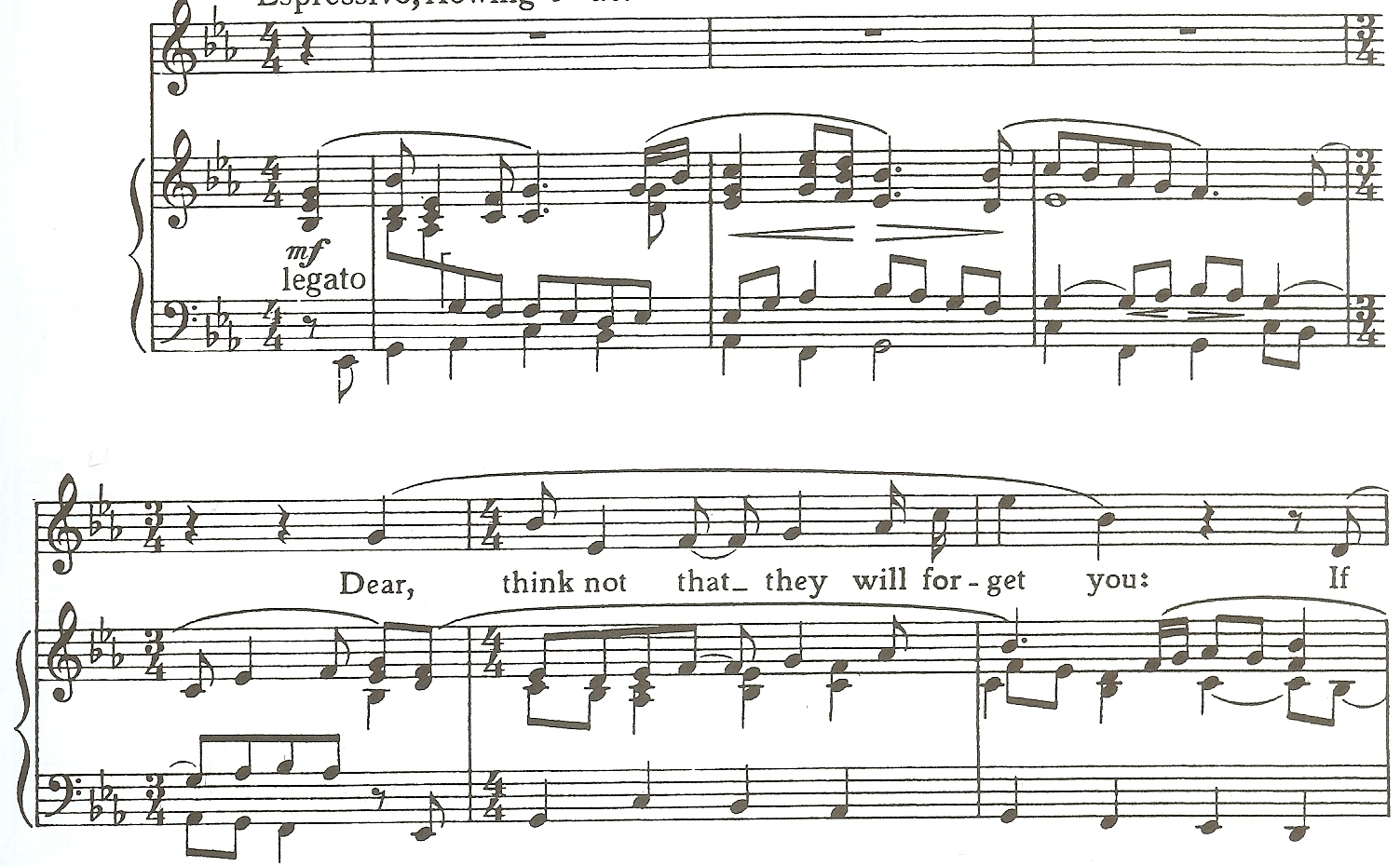
"There is little else of particular significance in the first section, with the exception of a small amount of programmatic melodic phrasing in measures 8 and 10 for the words, 'I will build up a temple, and set you Therein as its shrine.' First, the melody rises in measure 8 from E flat to G, then descends to f, all in quarter-note triplet fashion, in order to portray the sense of 'building up.' The melody continues its textual connection in measure 10 by rising in arpeggiated fashion to E in order to express the idea of 'setting one's love up as a shrine.' These are the only two moments in the first section when this compositional tactic is used, but they indicate Finzi's care for textual intent." (Carlisle, 121)
"Section two actually begins with upbeats in measure 12, and moves into a slower tempo than that of the first section. This section is characterized by the use of more chromaticism, as well as a melody that is slightly more expansive. It opens with a textural and rhythmical structure quite similar to that of the first section, including predominantly passing tones and eighth-note movement, but the melody expands rather rapidly to a¹ in measure 15 before descending throughout the remainder of the song. The dramatic thrust of the melody from measures 13-16 is meant to reflect the 'heaping of splendor' found in the text in measure 15, and this it does in fine fashion. It is not as graceful or elegant a melody as that of section one, but it does serve well the dramatic needs of the moment." (Carlisle, 121-2)
"It is clear that the portion of the text beginning with 'O, so sweet was her fame' and continuing to the end inspired within Finzi a dramatic intensity that he believed needed to be reflected in the music, so he chose the realm of harmony as the means to bring this across. Transitional chromaticism begins at the end of measure 14 and continues through to the final measure, concluding in the key of F minor. Once the chromaticism begins, no key area is ever really fully established, not even F minor. For instance, although the first sign of F minor is heard on beat one of measure 17, the resolution occurs by way of a minor rather than major V chord on beat four of the same measure. The final three measures of this piece are modal, producing an effect considerably more expressive than would a more traditional harmonic ending."
(Carlisle, 122)
"Although chromaticism occurs in the first four of the final six measures, most of the dissonance is mild. The only measure of substantial dissonance is measure 17, but it is this very dissonance that adds so much to the words 'None now knows his name!' and artistically sets up the lovely and expressive F minor resolution in measure 18. Finzi obviously felt these last words needed to be musically expressed with more 'bit' than normal, and the effect is on of almost aching poignancy that reflects so well the concept of a loving man no longer remembered." (Carlisle, 122-3)
Comments about Performance
"The opening musical markings of espressivo and legato indicate what Finzi was seeking to accomplish in this first section, and they are highly appropriate. The tempo marking of [quarter note] = c. 66, however, seems somewhat on the fast-paced side to accomplish those ends; a tempo of [quarter note] = c. 52 is far more capable of producing Finzi's desired effect than his own marking. This recommended tempo allows for more rubato than could be done with the original, in a piece that throughout absolutely requires musical give and take. Such musical spots as beat two of measure 4, beat one of measure 6, beat four of measure 9, and beat two of measure 15 all need a slight ritardando for better melodic phrasing. Also for the sake of musical phrasing, both accompanist and singer should incorporate a very slight accelerando during measures 8-9 and 14-15 in order to better tie together the poetic phrases." (Carlisle, 123)
"Other tempo markings such as meno mosso in measure 12, largamente in measure 13, and particularly poco ritardando in measure 17 should be observed as closely as possible. Dynamic markings are few, so some suggestions are in order. The opening for the accompanist is marked mezzo-forte, and the singer can adopt this dynamic level for his opening lines as well if he chooses. However, the text during the entire first section of this song is meant to be expressed tenderly, so if any different dynamic direction is taken it should be toward the softer end. The second section is different, and as Finzi has indicated a crescendo to forte in measure 15, there is no reason not to observe this. Finally, it is particularly important that both performers respect the pianissimo at the beginning of measure 17. As previously stated, this measure has much important musical expressiveness and poignancy, and these qualities would be substantially diminished if performed at a loud dynamic level." (Carlisle, 123-4)
"This is among the technically easiest pieces in this cycle, with a text that is not particularly difficult to understand or interpret. The only difficult spot technically for a young tenor might be the approach to a¹ in measure 15, but as this is not a sustained note, it would probably cause few if any problems. The tessitura in general is quite acceptable, so it would not be out of line to suggest this particular song to a relatively young tenor. Naturally, he would need some minimal literary and artistic skills, but a junior or senior undergraduate student should be more than capable of providing a very satisfying performance. It is one of the most inherently beautiful pieces in this cycle, and should be seriously considered by any who appreciate the unique qualities of the English solo song." (Carlisle, 124)
Unpublished Analysis Excerpts
The following is an analysis of Her Temple by Leslie Alan Denning. Dr. Denning extended permission to post this excerpt from his dissertation on September 8th, 2010. His dissertation dated May 1995, is entitled:
A Discussion and Analysis of Songs for the Tenor Voice Composed by Gerald Finzi with Texts by Thomas Hardy
This excerpt begins on page fifty-nine and concludes on page sixty of the dissertation.
"'Her Temple' is one of those songs which might be overlooked if it were not included within a cycle. This expressive song contains great emotion within its twenty measures and is actually a pivotal point in the cycle. the poem is derived from Hardy's Late Lyrics as was 'A Young Man's Exhortation.' The vigorous tones of 'Budmouth Dears' have dissipated as poet and composer again present the common theme of the ceaseless passing of time. The character now imagines his own past obscurity, yet assures his lover that she will be remembered due to his praise."
(Denning, 59-60)
"The style of the song is typical of Finzi's ballads. The accompaniment is primarily imitative and employs many passing tones and suspensions for interest. To accommodate the prose, Finzi has again employed a melodic and rhythmic pattern in the vocal line which is quite imitative of speech. Often the true meter and tonality are blurred by uses of syncopation and inverted chords as well as placement of accented syllables in weak parts of the measures. One of Finzi's favorite chordal progressions, the inverted submediant chord moving to an inverted tonic, is evident as well. All of these devices spring forth from the first vocal entrance throughout the piece (musical Example 7)."
(Denning, 60)
"Example 7: Her Temple, Measures 4-6." (Denning, 60) |

"The end of 'Her Temple' shows several other typical devices used by Finzi, namely passing tones, the use of the triplet at the height of the vocal line, and the employment of a quiet ending reflecting Hardy's cryptic text. The ending is made more emphatic by the modulation into f-minor and intense harmonic movement (musical Example 8)."
(Denning, 60)
"Example 8: Her Temple, Measures 14-19." (Denning, 61) |
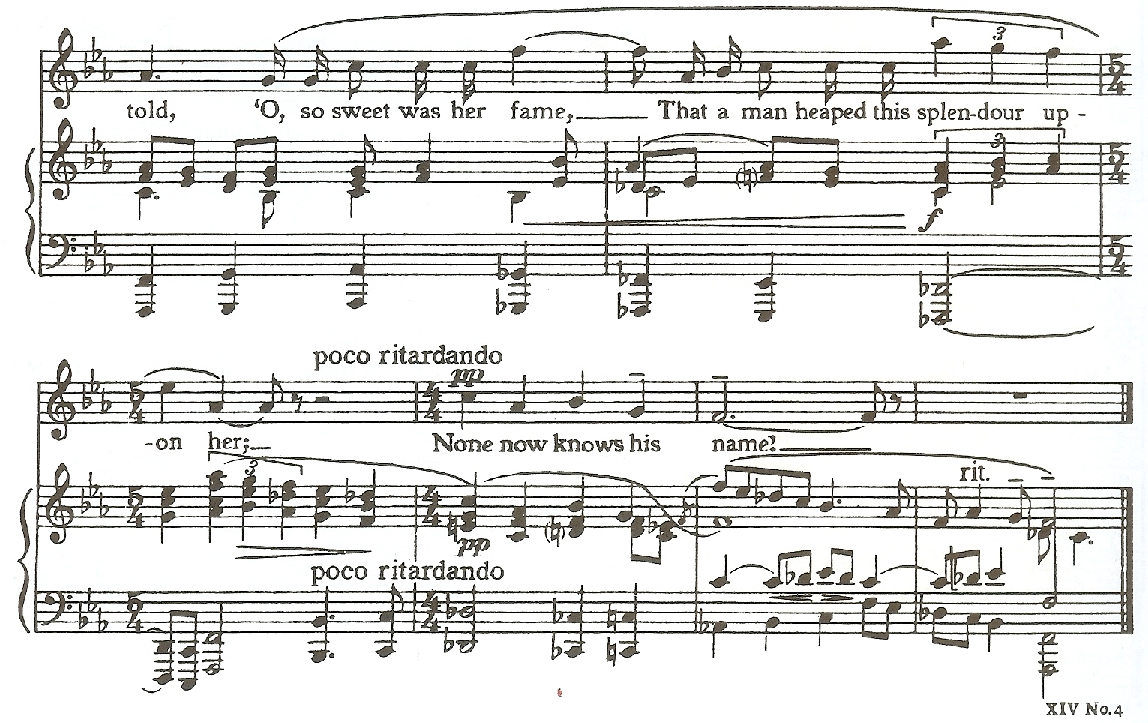
"'Her Temple' is an effective and expressive piece. Within its twenty bars the performer is given the opportunity to convey emotions in several dimensions, thus requiring careful study of the text for the true depth of the message. The lyricism and flow of the vocal line is difficult to convey due to great leaps and rhythmic shifts; however, the expression comes easily, due to Finzi's writing style. There is a certain control present in his composition here that does not allow the performer to stray too far from his intent."
(Denning, 61)
Unpublished Analysis Excerpts
The following is an analysis of Her Temple by Carl Stanton Rogers. Permission to post this excerpt was extended by Dr. Rogers' widow, Mrs. Carl Rogers on March 1st, 2011. Dr. Rogers' thesis dated August 1960, is entitled:
A Stylistic Analysis of A Young Man's Exhortation, Opus 14, by Gerald Finzi to words by Thomas Hardy
This excerpt begins on page thirty-four and concludes on page thirty-eight of the thesis. (Rogers, 34-38)
Part I, Number 4
"Her Temple"
Two general characteristics of this song are:
(a) The text setting is syllabic throughout.
(b) The song is through-composed; it consists of two stanzas; therefore, its form is A B.
One commentator has called this poem "an excellent picture of the mind of a grieving man," (Southworth, 181 as quoted by: Rogers, 34) and Grove's Dictionary has this to say concerning Finzi's setting of it:
It was in the two song cycles to words by Thomas Hardy that Finzi's distinguished treatment of words reached its peak. Hardy's poems are notoriously difficult to set to music, but in A Young Man's Exhortation and Earth and Air and Rain -- a total of twenty settings -- Finzi seems to have overcome the difficulties almost entirely. His settings achieve a unity of form which makes them unique among musical versions of Hardy, and some of them, e. g., "Her Temple" and "The Comet at Yell'ham," are well-nigh perfect. . . .(Avery, 136 as quoted by: Rogers, 34)
In order to have some basis for the discussion of the architecture of the melody of "Her Temple," both stanzas are given below:
Dear, think not that they will forget you:
They may say: "Why a woman such honour?"
If craftsmanly art should be mine
I will build up a temple, and set you
Therein as its shrine.
Be told, "O, so sweet was her fame,
That a man heaped this splendour upon her;
None now knows his name."
The melody begins a gradual ascent with the words "If craftsmanly art should be mine," hesitates briefly, and then ascends quickly through the interval of an octave to a rather broad climax on the word "up" in the third line. On the words "and set you therein" the melody descends as though giving the feeling of rest or repose; again, however, it ascends quickly to the climax note of the phrase on the word "shrine." The deliberate descending scale line used on the words " 'Why a woman such honour?' " occurs concomitantly with a forceful and positive ascending scale line in the piano accompaniment, as though affirming strongly the grieving man's determination to build the temple in spite of the doubts and questionings of others. (See Figure 15). The melody begins its final and most decisive ascent with the words " 'O, so sweet was her fame' " and the point of greatest climax of the entire song occurs on the word "splendour." The melody makes a final descent on the words "None now knows his name," as though the man, despite his grief and his achievement, has already been forgotten.
Once again, in order to facilitate a study of the scale used by the composer in this song, Table VI outlines the duration of each of the scale steps involved.
EMPHASIS ON SCALE DEGREES OF "HER TEMPLE"
BY DURATION*
Scale Degree |
Number
of Beats |
|
1 |
. . . . . . . . . . . . . . . . . . . . . . . . . . . . . . . . . . . . . . . . . . . . . . . . |
10 2/3 |
3 |
. . . . . . . . . . . . . . . . . . . . . . . . . . . . . . . . . . . . . . . . . . . . . . . . |
8 5/6 |
2 |
. . . . . . . . . . . . . . . . . . . . . . . . . . . . . . . . . . . . . . . . . . . . . . . . |
7 5/6 |
5 |
. . . . . . . . . . . . . . . . . . . . . . . . . . . . . . . . . . . . . . . . . . . . . . . . |
6 1/4 |
6 |
. . . . . . . . . . . . . . . . . . . . . . . . . . . . . . . . . . . . . . . . . . . . . . . . |
6 1/4 |
4 |
. . . . . . . . . . . . . . . . . . . . . . . . . . . . . . . . . . . . . . . . . . . . . . . . |
5 2/3 |
7 |
. . . . . . . . . . . . . . . . . . . . . . . . . . . . . . . . . . . . . . . . . . . . . . . . |
1 |
*[quarter note] = unit of the beat |
That this scale is related, as have been those of earlier songs, to the primitive English folk-song scales discussed by Cecil Sharp is borne out by the following considerations:
(a) The melody fluctuates between a major and minor feeling; it begins with a tonal center of E-flat major and ends with a tonal center of F-minor.
(b) The seventh scale step plays an insignificant part in the melody, both in number of occurrences (a total of three) and in its total duration.
These characteristics place this scale in a classification already discussed in connection with another song (See Figure 8); that is, the derivative six-note scale of pentatonic Mode I labeled as "Hexatonic a."
The harmony of the song, at least in the first section, is tertian. At the beginning of section B, a bit of contrapuntal activity takes place on the words " 'Why a woman such honour?'." This has already been discussed in connection with the architecture of the melody. In this instance, the ascending contrapuntal lines take place in the upper voices of the piano accompaniment. The bass line descends in octaves. here again, a similarity can be seen between this stylistic characteristic and music of the Baroque period in which the upper parts are supported by the thorough-bass part, as shown in Figure 15.
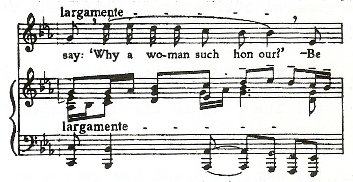
Fig. 15 -- "Her Temple," measure 13, contrapuntal activity against the bass line.
The harmonic device of harsh dissonance in the piano accompaniment is used on the final line of the song, "None now knows his name," to indicate again the tension and frustration of the grieving man. This tension is only briefly relieved in the next to the last measure, and the feeling of emptiness and loss is reinforced by the final chord of the piece, a "chord of omission"; (Dallin, 70) that is, a triad lacking a third. The final phrase under discussion is shown in Figure 16.
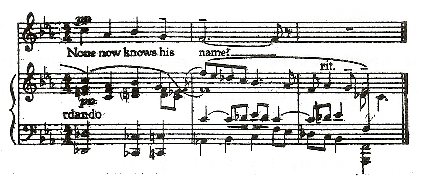
Fig. 16 -- "Her Temple," measures 17, 18, 19, the final phrase of the song.
The preceding was an analysis of Her Temple by Carl Stanton Rogers. Permission to post this excerpt was extended by Dr. Rogers' widow, Mrs. Carl Rogers on March 1st, 2011. Dr. Rogers' thesis dated August 1960, is entitled:
A Stylistic Analysis of A Young Man's Exhortation, Opus 14, by Gerald Finzi to words by Thomas Hardy
This excerpt began on page thirty-four and concluded on page thirty-eight of the thesis.
Unpublished Analysis Excerpts
The following is an analysis of Her Temple by Michael R. Bray. Dr. Bray extended permission to post this excerpt from his thesis on March 19th, 2011. His thesis dated May 1975, is entitled:
An Analysis of Gerald Finzi's "A Young Man's Exhortation"
This excerpt begins on page twenty-nine and concludes on page thirty-four of the thesis.
(Bray, 29-34)
HER TEMPLE
|
||
|---|---|---|
DEAR, think not that they will forget you: |
||
|
||
I will build up a temple, and set you |
||
|
||
They may say: ‘Why a woman such honour?’ |
||
|
||
That a man heaped this splendour upon her; |
||
|
"Her Temple" echoes the thought of Shakespeare's sonnet XVIII: "So long as men can breathe, or eyes can see, / So long lives this, and this gives life to thee." (Bailey, 466) The woman in the poem is thought to be Hardy's first wife, and the "temple" the "Poems of 1912-13." Emma Gifford, his first wife, died in 1912 and the poem is an epitaph of sorts as he contemplated his love for her. Even Hardy's self image as an obscure poet is revealed as he admits "None now knows his name."
The mood is distinctly different from the previous songs. As set in the tempo markings, the song takes on more reflective shades. The legato opening phrase is like the calm after a storm. Surprisingly, this is an accurate account. The things which Hardy loved the most - rural country life, his work, his wife - were almost sacred to him an d certainly beyond the reaches of society. This poem is almost a plea of self reassurance that his wife would not fade into obscurity of memory.
Similar to "Budmouth Dears," Finzi introduces the melody in the first measure of the accompaniment. Visibly, however, it is different. The two, three, and four-measure phrases seen in the first songs are here replaced by short one measure phrases. The impression is one of short but beautiful glimpses at loveliness. And loveliness is easy to find.

EXAMPLE 9: "Her Temple" measures 1-3.
In the first four measures, Finzi clusters together the most concentrated array of seventh and ninth chords yet to be seen. Serving as a healing salve, the seventh and ninth chords appear wherever there is a leap in the melody. The inner voices walk their way stepwise into the lush patterns.
This characteristic "walking bass" line again helps achieve the legato line called for. Measures 5-6 merely outline the C minor scale. This steady foundation also serves to contrast the syncopated melody that overrides the harmony. The end of the first verse sees the return of the introduction in full. This unifying return, however, is cleverly hidden beneath the melody line, which at this point climaxes on the longest held note thus far. But, as the introduction carries us into the second verse, Finzi slows down the motion with tenuto markings and a ritardando. Example 10 pictures this change.
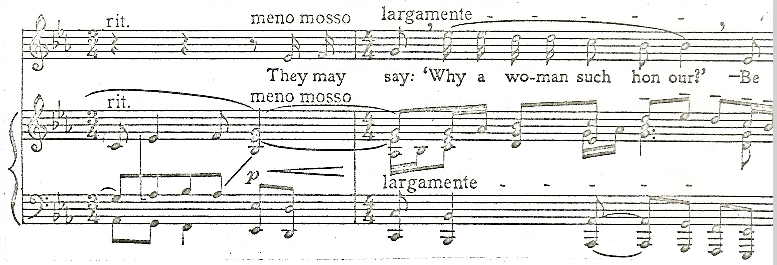
EXAMPLE 10: "Her Temple" measures 12-13.
Recall here the treatment of the following phrases: ". . . that your soul contains. / For what do we know best . . ." from "A Young Man's Exhortation" and ". . . that she is nought, / Even as I . . . " from "Ditty." These three examples point to a writing technique distinctly Finzi in character. (When Hardy comes to the crux of what he is trying to say, the poem becomes very personal. In the case of "Her Temple" the matter of intense importance is his wife. This is manifested either by what he says or by the personal pronouns used.) In approach of these change of moods, Finzi slows the motion down with tenuto marks and a ritardando. The voice then sings in a quasi-recitative style adding poignancy to the poetic line. Another stylistic device occurs in the accompaniment. As if "adding" weight to the desired effect, Finzi marches the bass line in scalewise motion downward very low in the register (lowest D-falt on the keyboard). These low octaves in the left hand add very rich foundation sonorities insuring the firmness demanded by the text.
The song is established in E-flat major. Throughout the first verse the harmony is very functional. The seventh chords move according to accepted root movement. However, as Finzi works towards the climax, the chords lose their functional purpose and begin to act as brush strokes for a piece of brilliant text painting. In the eighth measure, the phrase "I will build up a temple . . ." is set in ascending tones of the triad literally "building up" a phrase. Also, the quarter-note triplet figure elongates the effect that is enriched by seventh chord harmonies. In measure fourteen, one measure prior to the climax, Finzi melodically starts to build as two adjacent fourth leap upwards. In that same phrase, the word "sweet" is subtly pictured with an A-flat seventh chord. Directly following this seventh chord are e-flat and d-flat minor chords, foreign to the harmony thus far. However, the disjunctness of these chords is used as a springboard towards the heighth of the phrase. As Hardy reaches the point of the poetic phrase - "that a man heaped this splendour upon her;" - Finzi reaches the bottom of the downward bass movement. Not only does he use a D-flat seventh chord in the outpouring of jubilant "splendour" and climax the word splendour on the highest note in the song, but here again, he purposefully lingers on this emotional pinnacle with a quarter-note triplet figure. After the tension is released through a similar descending triplet, the final phrase leaves a cloud of obscurity.
Hardy was well aware of his relative obscurity as well as his lack of popularity and the effect Finzi is able to achieve makes a believer. Throughout the song, the melody has been an assorted array of syncopated rhythms, large leaps, sixteenth notes, and varying tempos.
Now, however in a hushed pianissimo, the melody moves in even quarter notes in alternating thirds and seconds.

EXAMPLE 11: "Her Temple" measures 16-19.
The right hand in the final two measures brings a total sense of unity as this closing theme also was the introduction for both verses. The harmony in measure seventeen achieves in perfect union what both Hardy and Finzi sought - obscurity. But the sound that remains after all is finished, is the openness of the fifth that imparts the desolation Hardy must have experienced with the finality of his aloneness.
The preceding was an analysis of Her Temple by Michael R. Bray. Dr. Bray extended permission to post this excerpt from his thesis on March 19th, 2011. His thesis dated May 1975, is entitled:
An Analysis of Gerald Finzi's "A Young Man's Exhortation"
This excerpt began on page twenty-nine and concluded on page thirty-four of the thesis.
(Bray, 29-34)
Unpublished Analysis Excerpts
The following is an analysis of Her Temple by John Keston. Mr. Keston extended permission to post this excerpt from his thesis on September 30th, 2011. His thesis dated May 1981, is entitled:
Two Gentlemen from Wessex: The relationship of Thomas Hardy’s poetry to Gerald Finzi’s music.
This excerpt begins on page seventy-one and concludes on page seventy-six of the thesis. To view Mr. Keston's Methodology please refer to: Methodology - Keston.
HER TEMPLE
|
||
|---|---|---|
DEAR, think not that they will forget you: |
||
|
||
I will build up a temple, and set you |
||
|
||
They may say: ‘Why a woman such honour?’ |
||
|
||
That a man heaped this splendour upon her; |
||
|
POETIC METER
"Her Temple" is not easily analyzed metrically, being a mixture of trochaic and iambic meters with interpolated anapests in the following manner: In the first stanza line one has three trochaic beats and one anapest. Line two has one iambic stress and two anapests; line three is made up of three anapests; line four is built of three trochaic beats. Stanza number two is constructed as follows: line one is made up of three anapests; line two has, similarly to stanza one, one iambic stress and two anapests; line three, three anapests; line four is a simple trochaic three beat measure.
RHYTHMIC RELATIONSHIP
In this musical setting of "Her Temple" Finzi has been masterful in his interpretation of complicated poetic rhythms. Again Finzi employs mixed meter for this song. The introduction is in four four time and the first word of the text is the last quarter note in a three four bar. The meter then returns to four four time. It is most interesting to note Finzi's treatment of the anapests used in Hardy's poetic meter. The anapest is two unaccented syllables followed by one stressed one and Finzi treats them in this way. Line one anapest, "will forget," receives two sixteenth notes for the unaccented syllables or beats and a quarter note for the stressed one: line two "craftsmanly art should be mine: is interpreted with the use of two sixteenth notes for the unaccented beats of ". . manly" and an eighth note stress for "art" being one of the important words in this line. The second anapest in this line, "should be mine," receives two sixteenth notes on "should be" and a dotted quarter for the stress of "mine." Throughout the song the anapests are mostly treated in this way.
TRANSLATION
This poem needs little explanation since Hardy has not obscured its meaning by the use of Victoriana or innuendo. His sentiments of regard, deep love and emotion for the woman are plainly evident. It would appear that he has little regard for himself (as do many young men who find themselves madly in love) witnessed in the last line, "none now knows his name." One conjectures that perhaps having trained as an architect, the thought of building a shrine to the loved one was a natural consequence of his acute knowledge of places of worship, gained through the intimacy of analyzing and remodelling those structures.
WHOSE SHRINE
The woman of this poem, "Her Temple," was probably Hardy's first wife Emma. The "temple" is thought to be Hardy's "Poems of 1912-13". (Bailey, 466) These poems were written in a burst of literary energy that swept over Hardy after Emma died. "Her Temple echoes the thought of Shakespeare's sonnet XVIII: 'So long as men can breathe, or eyes can see,/ So long lives this, and this gives life to thee.' . . . 'Her Temple' has been set to music (also) by John Ireland in Five Poems by Thomas Hardy (Oxford University Press, 1927)." (Bailey, 466)
The preceding was an analysis of Her Temple by John Keston. Mr. Keston extended permission to post this excerpt from his thesis on September 30th, 2011. His thesis dated May 1981, is entitled:
Two Gentlemen from Wessex: The relationship of Thomas Hardy’s poetry to Gerald Finzi’s music.
This excerpt began on page seventy-one and concluded on page seventy-six of the thesis.

